The week at a glance
- Wood Duck in Shetland
- Buff-bellied Pipits in Shetland and Orkney
- Empidonax sp. in Norfolk
- White's Thrush in Shetland
- Pallas's Grasshopper Warbler on Shetland
- House Crow in Co Cork
- House Finch in Devon
- Northern Parula in Argyll
The Northern Isles continued to be the place to be, with more new arrivals of the highest order from the east and west. Further south, the east coast enjoyed one of the best migration days for years, with a massive arrival of birds mid-week.
Of the new megas, plenty of debate centred around the arrival of a juvenile Wood Duck on Fair Isle (Shetland) on 29th. Its credentials look to be as good as any, with a reasonable supporting cast of Nearctic migrants over the last couple of weeks, but its acceptance will always be argued over.
Fair Isle also held onto a Buff-bellied Pipit until 29th, with others also arriving at Yesnaby (Orkney) on 27th — a second for the island — and Esha Ness (Shetland) on 28th-29th — the first for 'non-Fair Isle' Shetland.
Also from the west came the bird of the autumn (so far), when an Empidonax flycatcher was found, in appalling weather, in the plantation on Blakeney Point (Norfolk) on 25th-27th. From an initial identification as Alder/Willow Flycatcher, it soon became a possible Yellow-bellied Flycatcher, partly supported by photographic evidence showing very yellow colouration, particularly on the throat. This possibility could be ruled out with a close examination of the wing formula from photos, but only once confusion over whether the first (or tenth!) primary was vestigial was sorted.
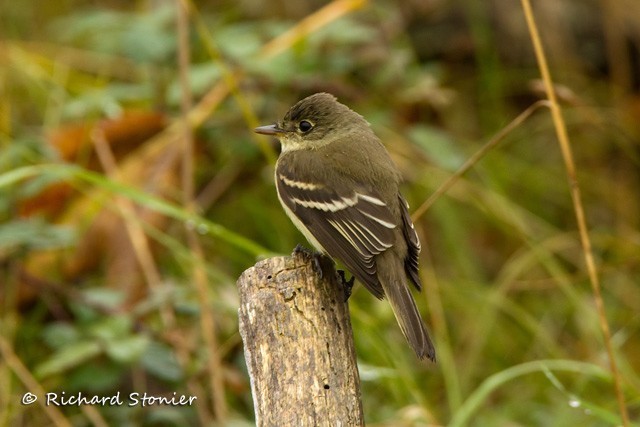
Empidonax sp., Blakeney Point, Norfolk (Photo:
Richard Stonier)
Empidonax sp., Blakeney Point, Norfolk (Film: SmallyBJ1).
Shetland's purple patch also saw a White's Thrush at Sandwick on 26th, with the Fair Isle Pallas’s Grasshopper Warbler also remaining until 26th. The claim of a Brown Flycatcher at Sumburgh late in the evening on 22nd was withdrawn by the observers, and may have related to a Spotted Flycatcher.

Pallas's Grasshopper Warbler, Fair Isle, Shetland (Photo:
Dougie Preston)
Elsewhere, the 'south' could only muster the House Crow, which continued to perform well in Cobh (Co Cork) all week, and the male House Finch was also seen on and off at East Prawle (Devon) to 26th at least.
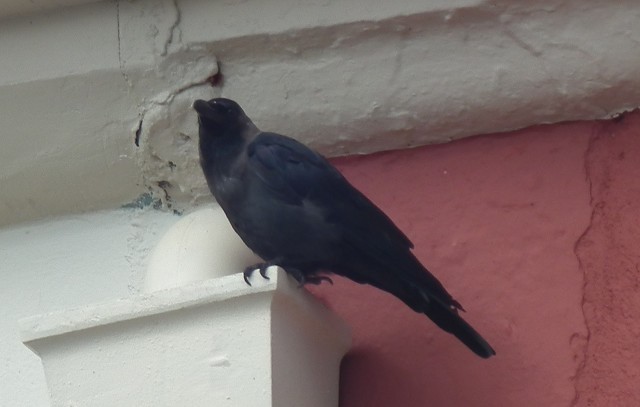
House Crow, Cobh, Cork (Photo:
Stephen Gibson)
Last, but certainly not least, was a stunning Northern Parula at Carnan Mor, Tiree (Argyll) on 25th-29th. This is the first record for Scotland and apart from a moribund bird in Wigan (Manchester) in 1982, the only one away from the south coast or England or Ireland. Being the first twitchable Parula since the Scillies bird of 1995, Tiree proved to be a popular, if distant, destination.
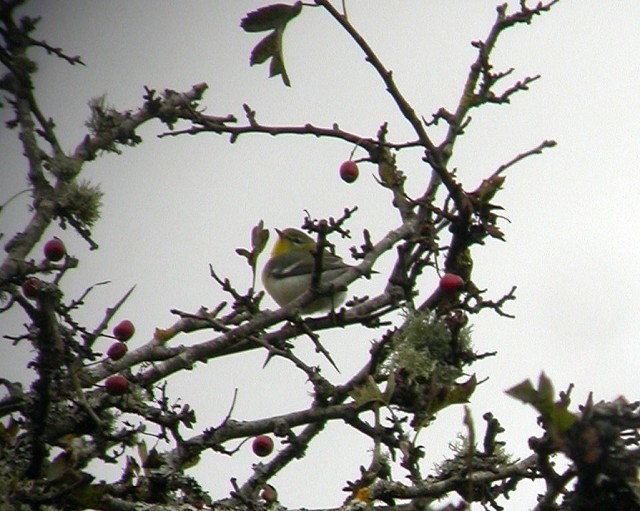
Northern Parula, Tiree, Argyll (Photo:
John Bowler)
Best of the rest begins with, the adult Ross’s Goose that remained with 5,000 Barnacle Geese at Caerlaverock (Dumfries & Galloway) to 28th. Two were also still with Pink-feet, commuting between Aberlady Bay and Gullane (Lothian) to 29th.

Ross's Geese with Pinkfeet, Gullane, Lothian (Photo:
James Wood)
Chew Valley Lake (Somerset) continued to hold some interesting ducks, with up to three drake Ferruginous Ducks during the week and the drake Ring-necked Duck again on 23rd. Another drake was at Martin Mere (Lancashire) on 26th.
There were still plenty of Blue-winged Teals around, including a female/immature at Risley (Cheshire) on 23rd. All the others were in Ireland, at Tacumshin (Co Wexford), Shannon Airport Lagoon (Co Clare), Courtmacsherry (Co Cork), Bull Island (Co Dublin), Achill Island (Co Mayo) and Ballyshunnock Reservoir (Co Waterford). The latter bird then moved to nearby Knockaderry Lake, with two there on 26th-28th. There were also two at Smerwick Harbour (Co Kerry) on 25th.
Other new arrivals were an adult drake Lesser Scaup at Draycote Water (Warwickshire) on 24th-29th — the second for the site — and an adult drake Surf Scoter off Marazion (Cornwall) on 26th-29th, with presumably the same off Penzance on 29th. The first-winter drake King Eider was also again off the Suffolk coast, seen at Minsmere and Dunwich Cliffs all week.
The only big shearwaters of the week were Cory's Shearwaters past Farne Islands (Northumberland) on 23rd and Spurn (East Yorkshire) on 26th. There were various reports of east coast Sooty Shearwaters, peaking at 512 past Flamborough Head (East Yorkshire) on 26th, 322 past Farne Islands (Northumberland) on 24th and 226 past Filey Brigg (North Yorkshire) on 26th. In contrast, there are very few Balearic Shearwaters now, with most records coming from the SeaWatch SW watchpoint at Porthgwarra (Cornwall), peaking at 49 on 26th. The only other count of note was 13 past Pendeen (Cornwall) on 23rd.
Interestingly, after the notable passage last week, numbers of Leach's Storm-petrel were well down, with very few reports submitted. Most of these now came from the east coast, with birds past Reculver (Kent), Cley (Norfolk) and Flamborough (East Yorkshire) on 24th, Sheringham (Norfolk) on 24th and 25th and past Spurn (East Yorkshire) on 24th and 26th.
The bizarrest seawatching of the week though was past Foul Anchor in the Cambridgeshire fens, six miles south of The Wash, on 24th. A morning 'seawatch' counted three Pomarine Skuas, 42 Great Skuas, five Arctic Skuas, Gannet, seven Sandwich Terns, four Black Terns and an Arctic Tern.
Whilst some of the Glossy Ibis stayed put, many wandered widely. Long-stayers were at Aveton Gifford (Devon) to 23rd, three on the Otter estuary (Devon) to 25th, Cotswold Water Park (Wiltshire) to 28th, Stanpit Marsh (Dorset) to 29th and the colour-ringed bird at Avonmouth (Somerset) to 26th. There were then three at Ring Marsh (Co Wexford) on 23rd, with two to 25th, and three at nearby Lady's Island Lake on 28th. Other singles were briefly at a private site in Hereford on 27th, Lough Neagh (Co Tyrone) on 27th, Borth (Ceredigion) on 26th, National Wetland Centre (Carmarthenshire) on 26th and one or more at Titchfield Haven (Hampshire) and Keyhaven Marshes (Hampshire) on 26th, Agmering (West Sussex) on 26th and Middlebere (Dorset) on 25th.
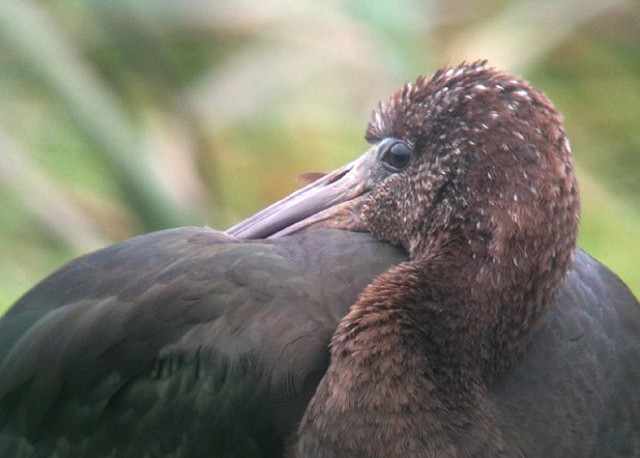
Glossy Ibis, Stanpit Marsh, Dorset (Photo:
Samuel West)
Dorset hogged all the White Storks, with singles at Blandford Forum (Dorset) on 23rd-25th, Rodden on 26th and Wareham on 26th-27th.
The long-staying Great White Egrets remained at Shapwick and Meare Heath (Somerset), Idle Valley (Nottinghamshire) and Blashford Lakes (Hampshire) all week. Others were at Leighton Moss (Lancashire) on 23rd-28th, Thorney Island (West Sussex) on 28th, Ynyslas (Ceredigion) on 24th and possibly the same at Ynys-Hir (Ceredigion) the next day. The Cattle Egret remained at Nene Washes (Cambridgeshire) on 23rd, with another at Fingringhoe (Essex) on 28th-29th.

Great White Egret, Leighton Moss RSPB, Lancashire (Photo:
Paul Hargreaves)
Spoonbills were more widespread, and away from East Anglia singletons were reported from Lodmoor (Dorset), Banks Marsh (Lancashire), Shell Ness and Oare Marshes (Kent), Keyhaven Marsh (Hampshire), Dungeness (Kent) and various islands on the Isles of Scilly. There were then two over Lizard (Cornwall) on 25th and six at Brownsea Island (Dorset) on the same day.
Whilst it still seems early, there were records of Rough-legged Buzzard from Port Nis, Lewis (Outer Hebrides) on 25th-26th, Beverston (Gloucestershire) on 26th and one reported being mobbed by Common Buzzards over Shipley Country Park (Derbyshire) on 25th.
There was an intriguing report of a white morph Gyr Falcon at Morte Point (Devon) on 29th, so hopefully this will stick. Almost as unusual was a probable juvenile Red-footed Falcon — a very rare plumage in the UK — at Witcham (Cambridgeshire) on 23rd. There was also an unconfirmed report of a probable dark morph Eleonora's Falcon over the London Wetland Centre late morning on 27th, although no further details have been forthcoming about this bird.
The only Spotted Crakes remaining were at Unstead SF (Surrey) to 25th and Trimley Marsh (Suffolk) to 25th.
Juvenile American Golden Plovers were still being found, with birds at Ballycotton (Co Cork) on 27th-28th, Baleshare, North Uist (Outer Hebrides) on 28th and Carrahane Strand (Co Kerry) on 28th. Many of the Buff-breasted Sandpipers remained, but now seemingly in smaller groups. Singletons were reported at Davidstow Airfield (Cornwall), St Mary's (Isles of Scilly), Tiree (Argyll), Benbecula (Outer Hebrides), Loch Bee, South Uist (Outer Hebrides), Brough Ness, South Ronaldsay (Orkney) and Fair Isle (Shetland). Two were then with Golden Plovers at Scotney Gravel Pits (Kent) on 28th, with two at Esha Ness (Shetland) on 26th and three still at Tacumshin (Co Wexford) to 27th. There were some new arrivals though, with four on Oronsay (Argyll) and five on Colonsay (Argyll) on 26th and six at Carrahane Strand (Co Kerry) on 25th-29th.

American Golden Plover, Baleshare, N.Uist, Outer Hebrides (Photo:
Steve Duffield)

Buff-breasted Sandpiper, Carrahane Strand, Kerry (Photo:
James Hayes)
Pectoral Sandpipers were again widespread, seen in 25 counties during the week. 'Twos' were at Dungeness (Kent), Minsmere (Suffolk), Marshside RSPB (Lancashire) and Ballycotton (Co Cork), with four at Tacumshin (Co Wexford) and five at Loch Fada, Benbecula (Outer Hebrides). One unlucky juvenile at Tophill Low (East Yorkshire) was apparently taken by a Sparrowhawk.

Pectoral Sandpiper, Upton Warren NR, Worcestershire (Photo:
Chris Cook)
White-rumped Sandpipers remained at Black Rock Strand (Co Kerry) to 26th – with a Baird's Sandpiper there on 25th — and at Oare Marshes (Kent) to 28th. Other Baird's Sandpipers were still at Tacumshin (Co Wexford) to 27th and at Tullyhill (Co Down) on 26th.
A new Lesser Yellowlegs was found at, of course, Tacumshin (Co Wexford) on 25th-26th with another at Goldcliff Pools (Gwent) on 28th-29th. The only Spotted Sandpipers were birds still at Porth Hellick, St Mary’s (Isles of Scilly) and Turf (Devon) to the end of the week. Also from the west, the Long-billed Dowitcher was again at Connah's Quay (Clwyd) to 26th.

Spotted Sandpiper, Turf, Devon (Photo:
Charlie Fleming)
Apart from one at Rutland Water (Leicestershire) on 28th, Norfolk was home to all the week's Red-necked Phalaropes. Birds were at Stiffkey on 25th-27th, Cley Marsh (Norfolk) on 29th, and probably the same Kelling Water Meadow on 27th-29th. This last bird shared the pool with a Grey Phalarope on 27th. Other Grey Phals were seen past sites in Cornwall, Devon, East Yorkshire, Northumberland, Highland, Outer Hebrides, Cheshire and Co Clare, with peaks of nine past Pendeen (Cornwall) on 23rd and five past Reculver (Kent) on 25th. More obliging birds were at Skinflats Lagoon (Forth) again to 23rd, Conwy RSPB (Conwy) on 24th-29th, Rutland Water (Leicestershire) on 28th, Covenham Reservoir (Lincolnshire) on 28th-29th, Titchwell (Norfolk) on 27th-29th and two were at Cley Marsh (Norfolk) on 27th-28th.

Red-necked Phalarope and Grey Phalarope, Kelling, Norfolk (Photo:
Steven Lane)
First-winter Wilson's Phalaropes remained at Kilcoole (Co Wicklow) to 24th and Grove Ferry (Kent) to 23rd, with new birds at Tacumshin (Co Wexford) on 24th-28th and at Dowdeswell (Gloucestershire) on 29th.
White-winged gulls are perhaps becoming more regular, with Glaucous Gull at Cobh (Co Cork) on 23rd, Clonakilty (Co Cork) on 24th, Hoy (Orkney) on 25th and at Port Nis, Lewis (Outer Hebrides). Iceland Gulls were also at Norwick, Unst (Shetland) on 26th, a juvenile at Siadar, Lewis (Outer Hebrides) on 27th and the adult at Cobh (Co Cork) again on 29th.
There were no reports of the Co Kerry American Herring Gull, and the only Ring-billed Gulls were adults at Portrush (Co Antrim) again on 25th and at Westcliff-on-Sea (Essex) on 25th.
There were still numerous reports of Sabine’s Gull off all coasts, with 'twos' past Chapel Point (Lincolnshire) and Farne Islands (Northumberland) on 24th, and Reculver and Shell Ness (Kent) on 26th. There was also an inland bird, at Pitsford Reservoir (Northamptonshire) on 24th.

Sabine's Gull, Loch Ryan, Dumfries & Galloway (Photo:
Brian Henderson)
The Whiskered Tern remained at Inner Marsh Farm (Cheshire) to 24th and the second for Glamorgan was at Eglwys Nunydd Reservoir on 25th-29th — following one at Kenfig Pool in 2008. There was also a bird over Redwell Marsh (Norfolk) on 26th.

Whiskered Tern, Eglwys Nunydd Reservoir, Glamorgan (Photo:
Jeff Slocombe)
The juvenile White-winged Black Tern remained at Rutland Water (Leicestershire) on 24th and a probable juvenile was also over the Thames at Grays (Essex) on 23rd. This was presumably the same bird that dropped into the London Wetland Centre on 26th and then took up residence on The Serpentine in Hyde Park (London) from 27th-29th.
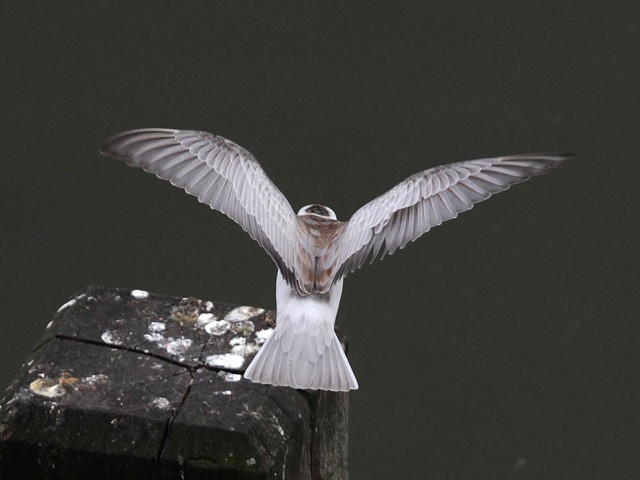
White-winged Black Tern, Hyde Park, Greater London (Photo:
Phil Wallace)
The regular female Snowy Owl was reported again from Blacksod (Co Mayo) to 26th, with no reports of the male on Lewis.
Inland Wrynecks remained at Wendover (Buckinghamshire) to 24th and Wanstead (London) to 24th, with coastal birds widely scattered, but few in number. There were three in Cornwall, Devon and East Yorkshire with two on the Isles of Scilly and singles in Dorset, Hampshire, Kent, Suffolk, Norfolk, North Yorkshire, Pembrokeshire and Co Cork.
An elusive Hoopoe was at Shiremoor (Northumberland) briefly on 24th with a slightly more obliging bird at Burscough (Lancashire) on 28th.
Richard's Pipits seem to have started arriving in numbers, with reports from, in date order, Hunstanton (Norfolk), Noirmont Point (Jersey), Blakeney Point (Norfolk), Porthgwarra (Cornwall) on 26th and 27th, Flamborough Head (East Yorkshire), Sennen (Cornwall), Margate (Kent), Easington (East Yorkshire), Donna Nook (Lincolnshire), North Ronaldsay (Orkney) and Waxham (Norfolk). Red-throated Pipits were reported from Kirkwall (Orkney) on 28th and at Gorleston-on-Sea (Norfolk) on the same day.
Fair Isle's Citrine Wagtail was present to 23rd, with others at Uig, Lewis (Outer Hebrides) on 23rd, Isbister (Shetland) on 26th and Beadnell Bay (Northumberland), with a possible briefly at North Repps (Norfolk) on 26th.
Seemingly a day later than most of the arrivals from the east, there was a small rush of Red-flanked Bluetails at the end of the week. One was ringed on Fair Isle (Shetland) on 27th, with an unringed bird then found later in the day. The next day saw new arrivals at Corton (Suffolk), Norwick, Unst (Shetland) and one was ringed on Fife Ness (Fife).

Red-flanked Bluetail, Corton, Suffolk (Photo:
Andrew Easton)
There were also several Bluethroats in the Northern Isles, including five on Fair Isle (Shetland) on 27th and two on Fetlar (Shetland) on 24th-25th. Further south, others were in a private garden at Hunmanby (North Yorkshire) for 20 minutes on 27th, Farne Islands (Northumberland) on 27th, one ringed at Gibraltar Point (Lincolnshire) on 28th and one on Blakeney Point (Norfolk) on 28th.
It was perhaps surprising there weren't more Barred Warblers this week, considering the weather, though there were perhaps as many as 35 new arrivals. Most were in the north and east, apart from Irish birds at Brownstown Head (Co Waterford), Baltimore (Co Cork), Dursey Island (Co Cork) and Three Castles Head (Co Cork). Peak counts were on Shetland, of four on Fair Isle and three at Uyeasound, Unst on 27th, with three on East Hills (Norfolk) on 28th.

Barred Warbler, Kelling, Norfolk (Photo:
Andy Thompson)
The first Lanceolated Warbler of the year was on Foula (Shetland) on 28th and there were three Blyth's Reed Warblers; at Dursey Island (Co Cork) on 26th-27th, Quendale (Shetland) on 27th and East Hills (Norfolk) on 28th. Quendale also held a Paddyfield Warbler on 27th. There was a late Great Reed Warbler, ringed at Slapton Ley (Devon) on 25th.
Icterine Warblers were much scarcer this week, with birds on St Mary's (Isles of Scilly) on 26th-28th, Lincolnshire birds at Grainthorpe Haven on 25th and Donna Nook on 28th, Orkney birds at Sanday on 26th and Deerness on 27th, with others at Scarborough (North Yorkshire) on 28th and Mizen Head (Co Cork) on 29th. A Melodious Warbler was ringed on Bardsey Island (Gwynedd) on 23rd, staying to 27th, with others at Norwick, Unst (Shetland) again on 25th-28th and at Sennen (Cornwall) on 25th.

Melodious Warbler, Sennen, Cornwall (Photo:
Adam Hartley)
A silent Bonelli's Warbler sp. in Wells Woods (Norfolk) on 26th-28th caused some interesting debate, though was probably a Western. Rumours of the bird giving a 'chip' call, suggesting Eastern, may have had no basis. Another Western was on Great Saltee (Co Wexford) on 26th.

Western Bonelli's Warbler, Wells Woods, Norfolk (Photo:
Kevin Du Rose)
There was an amazing run of Arctic Warblers on Shetland, with birds at Sumburgh on 23rd-27th, Kergord on 23rd-24th, Sullom on 26th, Norwick, Unst, and Fetlar on 28th. Conversely, the only Greenish Warbler was one at Sennen (Cornwall) on 25th-28th.

Arctic Warbler, Sumburgh, Mainland, Shetland (Photo:
Kris Gibb)
Greenish Warbler, Sennen, Cornwall (Film: chippler01).
With the mid-week easterlies came plenty of Yellow-browed Warblers. They started with a trickle of singletons on 23rd (Holy Island, Northumberland) and 24th (South Uist, Outer Hebrides), then five on 25th (four on Shetland and one at Kilnsea, East Yorkshire). Perhaps coincidental with the weekend, there were as many as 19 new birds on 26th, but another 23 on 27th, 20 on 28th and 15 on 29th. Additional to these totals, there were eight at Baltasound, Unst (Shetland) and an impressive 15 on Fair Isle on 27th.

Yellow-browed Warbler and Empidonax sp., Blakeney Point, Norfolk (Photo:
Adi Sheppard)
Norfolk also had a great run of birds this week, with Radde's Warblers at Stiffkey on 26th and on Blakeney Point on 28th.
Early in the week, a Red-breasted Flycatcher was at Kergord (Shetland) on 25th, with others at Orbister and Sandwick on 28th. Along the east coast, others were at Donna Nook (Lincolnshire) on 27th-28th, Spurn (East Yorkshire) on 27th-28th, three at Wells Wood/Holkham and one on East Hills (Norfolk) on 27th-28th, Isle of May (Fife) on 27th-28th, three on Fair Isle on 28th, Holy Island (Northumberland) on 28th-29th and Flamborough (East Yorkshire) on 29th.

Red-breasted Flycatcher, Spurn, East Yorkshire (Photo:
Paul Foster)
There was a notable arrival of Great Grey Shrikes from 27th, the first of the autumn, with three in East Yorkshire, two on the Farne Islands (Northumberland) and singles in North Yorkshire, Norfolk and another in Northumberland. The next day saw nine new birds, including three in Lincolnshire and two in East Yorkshire, and the 29th saw six more, from Durham to Suffolk.
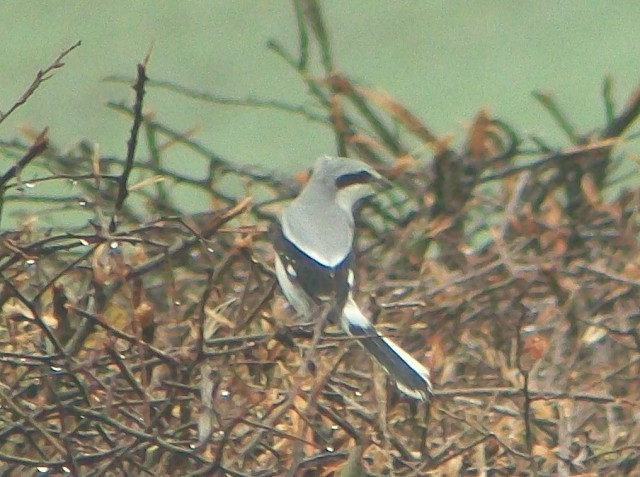
Great Grey Shrike, Flamborough Head, East Yorkshire (Photo:
Andy Hood)
The Woodchat Shrike remained at Three Castles Head (Co Cork) to 25th with a new, and attractive-if-scruffy, juvenile at Hartlepool Headland (Cleveland) on 26th-29th. Most Red-backed Shrikes seem to have moved on now, with just a juvenile at Sennen (Cornwall) to 24th, a male at South Gare (Cleveland) on 27th-28th and one on the Isle of May (Fife) on 27th reported.
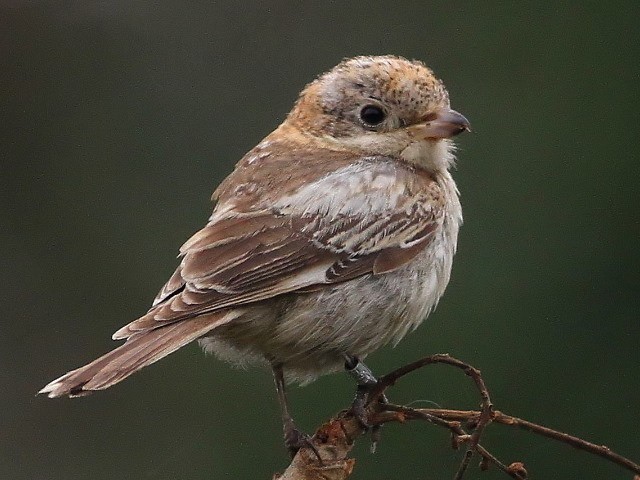
Woodchat Shrike, Hartlepool Headland, Cleveland (Photo:
Ian Forrest)
There was just one report of Rose-coloured Starling, from Gairnish Point (Co Cork) on 29th.
Various Hornemann's Arctic Redpolls remained, with birds on Fair Isle (Shetland) on 27th, Farne Islands (Northumberland) on 24th-27th, North Ronaldsay (Orkney) to 27th and Loch of Rummie (Orkney) on 26th. On Unst (Shetland), birds were still at Norwick to 28th, Haroldswick to 26th, Baltasound on 27th and Northdale on 29th.

Arctic Redpoll, Norwick, Unst, Shetland (Photo:
Mike Pennington)
Common Rosefinches were widespread across the Northern and Western Isles, with a maximum count of three on Fair Isle (Shetland). Further south, one was ringed at Portland (Dorset) on 25th, with others on Bardsey Island (Gwynedd) on 23rd, Farne Islands (Northumberland) on 23rd-27th, Dursey Island (Co Cork) on 26th-28th, Warham Greens (Norfolk) on 26th, Kilnsea (East Yorkshire) on 27th and Donna Nook (Lincolnshire) on 28th.
A rather early southern Little Bunting was on Tresco (Isles of Scilly) on 23rd, with another at Wester Quarff (Shetland) on 24th-25th. One also briefly showed to the Empid crowds at the plantation on Blakeney Point (Norfolk) on 26th and there were two Bird Observatory birds on 27th; at Spurn (East Yorkshire) and North Ronaldsay (Orkney). Perhaps the same Norfolk bird then was more obliging at Thornham (Norfolk) on 29th with one on the Farne Islands (Northumberland) on the same day.
Lapland Buntings were still numerous, especially in Scotland, though small numbers were seen all across the country. Regional maxima were:
- Scotland: 160+ at Bornish, South Uist (Outer Hebrides)
- NW England: singles in Lancashire, Cumbria and Isle of Man
- NE England: at least 50 at Horseshoe Point and North Cotes (Lincolnshire)
- N Ireland: two on Ramore Head (Co Antrim)
- Republic of Ireland: 11 at Kilcoole (Co Wicklow)
- Wales: 42 at Cemlyn Bay (Anglesey)
- Midlands: three at North Hill (Worcestershire)
- East Anglia: 10 at various sites in Norfolk
- SW England: 10 on St Agnes (Isles of Scilly)
- SE England: six over Sandwich Bay (Kent)
The first Rustic Bunting of the autumn was at Isbister (Shetland) on 27th-28th with another at Flamborough Head (East Yorkshire) on 28th. The Ortolan Bunting was still on Portland (Dorset) to 25th, with two again at Porthgwarra (Cornwall) on 25th and a new bird at Warsett Hill (Cleveland) on 28th.

Rustic Bunting, Isbister, Mainland, Shetland (Photo:
Dougie Preston)
It would be wrong to finish without mentioning some of the migrant totals from the fall on 27th and some of the best counts came from Spurn Bird Observatory (East Yorkshire). The ringing total for the day was an impressive 462 birds, including 234 Robin, 37 Brambling and 31 Song Thrush. Migrants continued to arrive during the day, with final totals of nine Jack Snipe, 25 Tree Pipit, 115 Dunnock, 1000+ Robin, 86 Redstart, 15 Whinchat, 85 Wheatear, 48 Ring Ouzel, 630 Song Thrush, 1200 Redwing, 15 Spotted Flycatcher, 12 Pied Flycatcher, 565 Brambling and 74 Reed Bunting.
Photo of the Week: 16th—22nd September
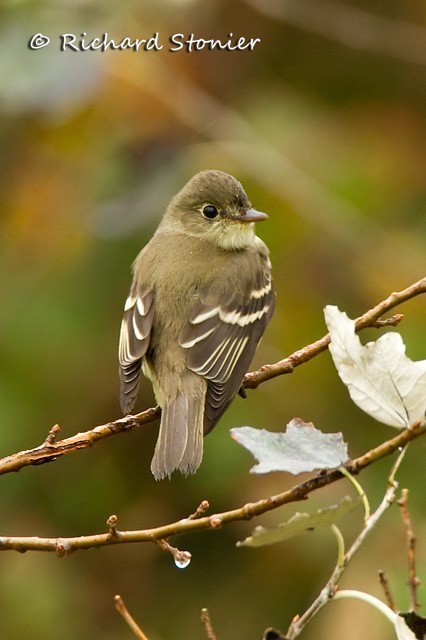
Empidonax sp., Blakeney Point, Norfolk (Photo:
Richard Stonier)
Nowadays, one of the main reasons for photographing birds is to record the fact that a particular bird was in a certain location at a certain time. Such 'record shots' may be taken just for personal interest but, especially in the case of rarities, it is now common for these to be shared in association with the news reports of the rarities (e.g. via BirdGuides). Once shared, these images can be used for reference by others who may wish to twitch the bird, or enjoyed by those unable to make it. In the case of significant rarities, record shots can confirm identification and provide evidence to support acceptance by the relevant authorities. For such shots, the most important thing is to ensure all structural and plumage details are clearly recorded. One of the best known specialists in this field is Richard Stonier, who travels the length and breadth of the UK with his camera in the pursuit of rare and scarce species. This week, Richard has captured a series of shots of a New World 'mega' on Blakeney Point, Norfolk, that still hasn't been conclusively identified after several days' deliberations by the experts (current opinion narrows it down to one of the Empidonax family, but with no consensus as to the species). As well as being ornithologically valuable, though, Richard proves that images of this type can still be aesthetically pleasing, especially with his over-the-shoulder portrait shot of this small American celebrity amidst autumnal vegetation.
Other notable photos

Blue Tit, Hampton, Worcestershire (Photo:
Mark Hancox)

Bearded Tit, Minsmere RSPB, Suffolk (Photo:
Jon Evans)

Common Kingfisher, Far Ings NR, Lincolnshire (Photo:
David Newby)
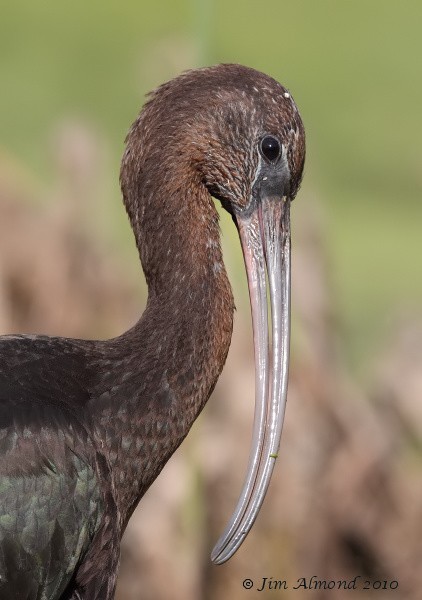
Glossy Ibis, Avonmouth, Somerset & Bristol (Photo:
Jim Almond)

Black-tailed Godwit, Mistley, Essex (Photo:
Bryan Wright)

White-backed Vulture, Kenya (Photo:
Nigel Forrow)
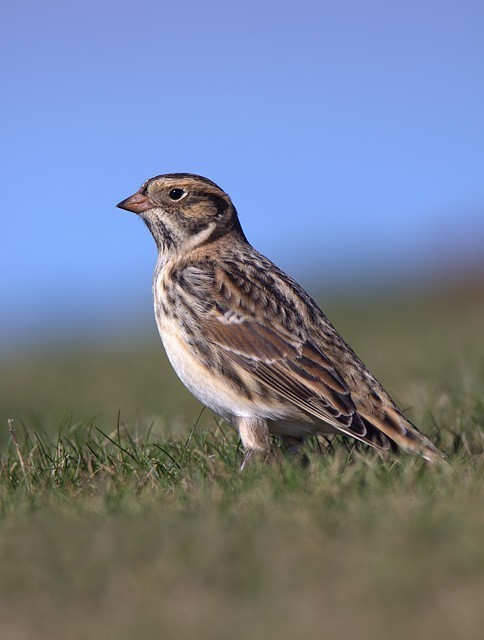
Lapland Bunting, North Hill/Chat Valley, Worcestershire (Photo:
Peter Walkden)

Northern Wheatear, Westleton Heath, Suffolk (Photo:
Ian Clarke)

Red-backed Shrike, Winterton-on-Sea, Norfolk (Photo:
Garth Peacock)

Honey Buzzard, Qatar (Photo:
Dileep Kumar)

Golden Plover, Oare Marshes NR, Kent (Photo:
Ian Curran)

Jay, London Wetland Centre WWT, Greater London (Photo:
Paul Farnfield)

Meadow Pipit, Ardnamurchan, Highland (Photo:
Ron McCombe)

Grey Phalarope, Conwy RSPB, Conwy (Photo:
Bob Garrett)

Spotted Sandpiper, Portugal (Photo:
Ivan Ellison)

Water Rail, Titchfield Haven NNR, Hampshire (Photo:
Stephen Burch)

Arctic Redpoll, Norwick, Unst, Shetland (Photo:
Mike Pennington)

Marsh Tit, Germany (Photo:
Siegbert Werner)

